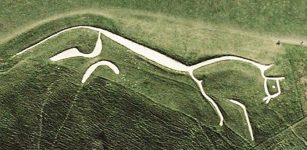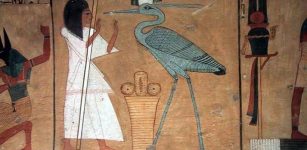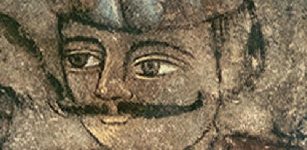Quest For The Magical Healing Flower In The Garden Of Bakavali Led To A Love Story
Ellen Lloyd - AncientPages.com - The description of the Garden of Bakavali can be found in Gul-e-Bakavali, one of the earliest Persian–Arabic and Hindustani stories collated by the British at the Fort William College in Calcutta at the turn of the nineteenth century.
The text mentions Gul, a flower that possesses extraordinary healing powers. It is believed to grow behind a legendary mountain called Kohi Kaff (today's Pamirs). Superhuman creatures and supernatural beings inhabit this region.
Magnificent Garden of Bakavali Was Not Easy To Find
Mythical gardens are always filled with the most beautiful trees, stunning flowers, and plants, and the Garden of Bakavali was a heavenly place.
The Garden of Bakavali was a magical place where one could find the most beautiful plants. Credit: Public Domain
"It is related that in the mythic Garden of Bakavali there grew trees of rubies with bunches of fruit so brilliant that they were equal to the clusters of stars which group themselves around the Tree of the Sun." 1
Like Greek nymphs guarded Hesperides, the fabled garden with divine apples of immortality, the Garden of Bakavali was also complicated to access. This was where magical plants grew, and the garden's location was kept secret, and only a few knew where it could be found.
Prince Taj-al-Maluke And The Quest For Gul, The Healing Flower
In the story, Zainal Maluke, a king of eastern lands, warns his astrologers to stay away from his son Taj-al-Maluke for 12 years because the young man is under a bad star. Unfortunately, the father sees his son and goes blind.
When Taj-al-Maluke is excommunicated for causing blindness to his royal father, he understands he must do something. He learns about a powerful flower that can restore sight and decides to go and search for it, but it is located in a garden that is almost impossible to reach.
Prince Taj-al-Maluke is a courageous young man who is not afraid of challenging obstacles. He travels to foreign lands where he encounters threatening creatures and dangers lurking wherever he goes. However, the young man is determined to find the flower to save his father. In some versions of the story, the prince learns about the healing flower from God Indra.
Like most heroes, Taj-al-Maluke is courageous, motivated, and unstoppable. As Amaresh Datta explains in the Encyclopaedia of Indian Literature, "his determination and single-mindedness in the face of all kinds of odds, natural as well as supernatural, is exceptional and most behaving of a typical hero. Even his cowardice and unscrupulous step-brothers conspire against him. Taj-al-Maluke not only outwits them but also saves rescues them from the bad situations."
It takes time, and the prince must overcome many dangers, but finally, he finds the mysterious Garden of Bavakali which is also home to a beautiful princess.
Prince Taj-al-Maluke had to find the magical flower to restore his father's eyesight. Credit: Public Domain
"Taj break into the Garden of Bakavali, steals the flower but loses his heart to the sleeping beauty Bakavali. The next morning Bakavali wakes to find to her utter disbelief her favorite flower gone and a golden ring on her finger. She pledges to avenge the theft. But in the process falls in love with Taj, gets betrothed to him, her parents punish her and turn her into stone. Taj-al-Maluke liberates her. But her woes do not end here. She is burnt alive, is born again in a poor family and gets married to Taj." 2
The story of the Garden of Bakavali and prince Tal-al-Maluke's quest for the magical flower Gul is a love story that is well-known throughout Asia, and there are various versions of this myth.
Updated on February 14, 2022
Written by Ellen Lloyd – AncientPages.com
Copyright © AncientPages.com All rights reserved. This material may not be published, broadcast, rewritten or redistributed in whole or part without the express written permission of AncientPages.com
Expand for references1. Alexander Porteous - The Forest in Folklore and Mythology
2. Amaresh Datta - Encyclopaedia of Indian Literature
More From Ancient Pages
-
 Obscure History Of Upper Mustang: Prehistoric Paintings Discovered In Nepal
Archaeology | Dec 21, 2017
Obscure History Of Upper Mustang: Prehistoric Paintings Discovered In Nepal
Archaeology | Dec 21, 2017 -
 On This Day In History: Mayan King Bird Jaguar IV Assumes The Throne – On May 3, 752
News | May 3, 2016
On This Day In History: Mayan King Bird Jaguar IV Assumes The Throne – On May 3, 752
News | May 3, 2016 -
 Siberian Neanderthals Were Intrepid Nomads – They Started Their Journey In Eastern Europe
Archaeology | Jan 29, 2020
Siberian Neanderthals Were Intrepid Nomads – They Started Their Journey In Eastern Europe
Archaeology | Jan 29, 2020 -
 Historical Artifacts Found In The Mammoth Cave’s Mysterious Passageway
Archaeology | Jul 12, 2022
Historical Artifacts Found In The Mammoth Cave’s Mysterious Passageway
Archaeology | Jul 12, 2022 -
 Archimedes’ Screw: Ancient Invention Used To Transfer Water To Higher Levels
Ancient History Facts | Aug 30, 2018
Archimedes’ Screw: Ancient Invention Used To Transfer Water To Higher Levels
Ancient History Facts | Aug 30, 2018 -
 First Dream Of The New Year – Japanese Hatsuyume Tradition
Ancient Traditions And Customs | Jan 1, 2021
First Dream Of The New Year – Japanese Hatsuyume Tradition
Ancient Traditions And Customs | Jan 1, 2021 -
 Hundreds Of Highly Unusual Burial Gifts Found In Special Viking Chamber Belonging To Woman In Norway
Archaeology | Nov 26, 2020
Hundreds Of Highly Unusual Burial Gifts Found In Special Viking Chamber Belonging To Woman In Norway
Archaeology | Nov 26, 2020 -
 Mysterious Mount Kailash: Secrets Of The Man-Made Pyramid And Entrance To The City Of The Gods
Civilizations | Oct 27, 2014
Mysterious Mount Kailash: Secrets Of The Man-Made Pyramid And Entrance To The City Of The Gods
Civilizations | Oct 27, 2014 -
 4,500-Year-Old Skeletons Found In SW China
Archaeology | Apr 19, 2016
4,500-Year-Old Skeletons Found In SW China
Archaeology | Apr 19, 2016 -
 Earliest Evidence Of Rice Harvesting Provided By China’s Ancient Stone Tools
Archaeology | Dec 8, 2022
Earliest Evidence Of Rice Harvesting Provided By China’s Ancient Stone Tools
Archaeology | Dec 8, 2022 -
 Mystery Of Prehistoric Gigantic Hill Figures Of England
Featured Stories | Sep 20, 2018
Mystery Of Prehistoric Gigantic Hill Figures Of England
Featured Stories | Sep 20, 2018 -
 On This Day In History: American Archaeologist George A. Reisner Was Born – On Nov 5, 1867
News | Nov 5, 2016
On This Day In History: American Archaeologist George A. Reisner Was Born – On Nov 5, 1867
News | Nov 5, 2016 -
 DNA Of Nine 13th Century Crusaders Provides A Glimpse Into Soldiers’ Life And Death
Archaeology | Apr 22, 2019
DNA Of Nine 13th Century Crusaders Provides A Glimpse Into Soldiers’ Life And Death
Archaeology | Apr 22, 2019 -
 Mysterious Osirion Of Abydos Egypt – Was It An Ancient Energy Plant?
Featured Stories | Feb 26, 2020
Mysterious Osirion Of Abydos Egypt – Was It An Ancient Energy Plant?
Featured Stories | Feb 26, 2020 -
 Mythical Egyptian Bennu Bird And Deity
Egyptian Mythology | Jun 5, 2016
Mythical Egyptian Bennu Bird And Deity
Egyptian Mythology | Jun 5, 2016 -
 Message In A Bottle Thrown Overboard In Germany 132 Years Ago Was Found In Australia
Archaeology | Mar 8, 2018
Message In A Bottle Thrown Overboard In Germany 132 Years Ago Was Found In Australia
Archaeology | Mar 8, 2018 -
 LIDAR Discovers Giant Ancient Mesoamerican Calendar – Structures Were Aligned To The Stars
Archaeoastronomy | Jan 10, 2023
LIDAR Discovers Giant Ancient Mesoamerican Calendar – Structures Were Aligned To The Stars
Archaeoastronomy | Jan 10, 2023 -
 Moll Cutpurse – London’s Queen Of Thieves
Featured Stories | Jan 15, 2019
Moll Cutpurse – London’s Queen Of Thieves
Featured Stories | Jan 15, 2019 -
 King David-Era Fort Unearthed In Golan Heights Sheds Light On Aramean Kingdom Of Geshur
Archaeology | Nov 14, 2020
King David-Era Fort Unearthed In Golan Heights Sheds Light On Aramean Kingdom Of Geshur
Archaeology | Nov 14, 2020 -
 On This Day In History: Vlad II Known As Vlad Dracul (‘Vlad The Dragon’) Was Born – On August 30, 1400
News | Aug 30, 2016
On This Day In History: Vlad II Known As Vlad Dracul (‘Vlad The Dragon’) Was Born – On August 30, 1400
News | Aug 30, 2016


